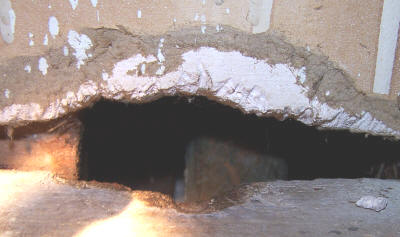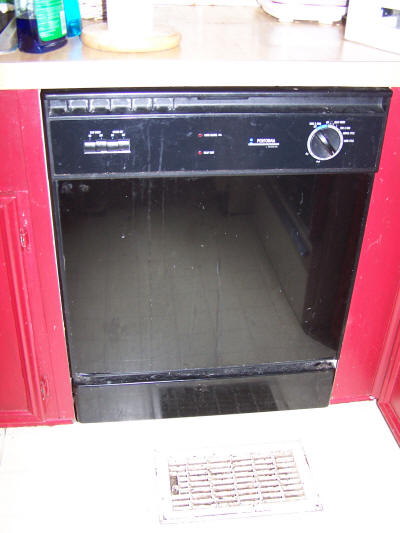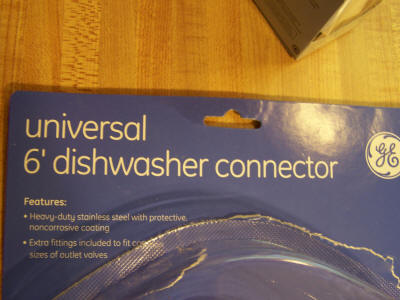Some stupid mice “gifted” me another opportunity to do household repairs.
On Thursday night, I noticed the dishwasher sounding a little strange. Halfway through the cycle, I found the inside was bone dry. Further investigation found–gulp–the floor was soaked!
I removed the dishwasher’s bottom cover and found that mice ate up part of a line:

This is part of the line that runs from the pump to the top sprayer. Thanks to the holes, the pump just sprayed water underneath the dishwasher.
Here’s a close up, after I removed it:

You can make out mouse teeth marks.
I can’t work on this from underneath, so out goes the dishwasher!

This isn’t an easy-to-find replacement part. Since the dishwasher is 10 years old, 4 years past when Consumer Reports recommends to replace it instead of repairing it (I agree with that assessment), I knew I would have to do a repair on the cheap or just get a new dishwasher.
Here’s the opening behind the dishwasher:

The floor is dark because the wood is soaked. See that hole just right of center? Close up:

See the teeth marks? That’s a sewer vent pipe behind. I guess they scampered up that?
Over to the left, the stupid mice made the beginnings of a cute little nest with plastic bits and fiberglass.

Next step is to stuff steel wool into all holes. Steel wool should keep the mice out.

The hole to the right was probably not an access port, but it could have allowed the mice entry into an area below an adjacent cabinet. (No food was stored there; just pet supplies.)
Then I set up a fancy drying system:

That’s a regular floor fan blowing heated air into the dishwasher cavity.
After it got dry enough, I caulked the heck out of the remaining openings:

The floor is pretty dry by this point.
This is the side of the dishwasher after I cut off the damaged piece of the pipe:

And my totally awesome repair:

Automotive heater core hose clamped on each end with a hose clamp. I was sure this would work fine because the plastic tube linked up with the pump with a soft rubber piece and a hose clamp.
It’s hard to make out, but this is where the line connects to the pump.

I put a small wire cage on part of this line where it hits against a metal edge to prevent constant rubbing from tearing a hole in the line:

While I had things apart, I noticed that the power supply line is an unswitched feed that comes off the switch for the food disposal. I would rather have a way to shut off the dishwasher circuit without throwing a breaker, so this:

became this:

I had to play a little logic game to figure out which wire went where, but it works great now.
Shove it all back in, turn it on, and we’re ready for another 10 years of service.

Wrong!
The stupid dishwasher’s pump has a leak, unrelated to the mice!
Here is what happened after running it for just a few minutes:

The pump is leaking! I have no idea how long this has gone on. However, the lack of warpage on the wood suggests that this is a new leak. The jostling of getting the dishwasher in and out may have encouraged this leak. I don’t see how I could have created the leak per se; the pump couldn’t have struck anything. I think something was probably about to “give,” and the movement made it finally give up.
If that’s not enough, this dishwasher supply line also leaks:

Let me tell you, this supply line is garbage. It’s an overpriced, $15 hose from Home Depot. Here’s the box top so you’ll know not to get it:

This piece of trash wouldn’t tighten. That is, it would loosen itself up some after each turn of tightening it. When I finally got it tight enough to stop backing out on me, it kept dripping. So I cranked it bit by bit until it stopped leaking, except that even after I knew I had applied way too much torque for a brass fitting, it still kept leaking!
Here’s what the end looked like once I got it off later:

Either Home Depot is selling complete trash for $15, or this product has poor quality control. $15 seems really high for a simple hose, anyway. I may check into something less expensive when I replace the dishwasher.
Yeah, that’s right, “replace.” It’s new dishwasher time. There’s no point in spending any more time on this dishwasher. It’s 10 years old and has outlived its economic life. Fortunately, Consumer Reports’s 3rd highest ranking dishwasher is a “best buy,” so a replacement shouldn’t hurt my pocketbook too much.